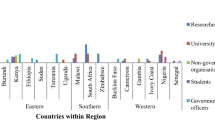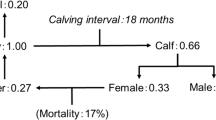Summary
The emphasis on cow records in Malaysian diary extension programmes reflects the importance of herd fertility in the economics of dairying. Manual record keeping has not been able to make an impact on management due to difficulties experienced in quality control of the data and in analysing the data to produce useful information for farm managers. Computerised recording systems have been in use in Malaysia since 1985, both on government farms and in the smallholder dairy sector. The aim of both systems is firstly to improve farm efficiency by the provision of information to managers and extension workers and secondly to provide information for departmental planning purposes. The systems used in Malaysia are outlined, and the results over the first three years of operation are summarised.
Résumé
L'accent sur l'enregistrement des performances des vaches dans les programmes de vulgarisation laitière en Malaisie reflète l'importance de la fertilité des troupeaux dans l'économie laitière. La tenue d'enregistrements manuels n'a pas permis d'obtenir un impact sur la conduite des exploitations en raison des difficultés rencontrées pour maîtriser la qualité des données et les analyser pour fournir des informations utiles aux gestionnaires des fermes. Les systèmes d'enregistrement informatisé sont utilisés en Malaisie depuis 1985 à la fois sur les fermes gouvernementales et dans le secteur des petites exploitations privées. L'objectif des deux systèmes est d'abord d'améliorer l'efficacité des fermes par la fourniture d'informations aux gestionnaires et aux vulgarisateurs, et ensuite, de fournir les informations nécessaires à la programmation ministerielle. Les systèmes employés en Malaisie sont esquissés et les résultats des trois premières années de fonctionnement sont résumés.
Resumen
El énfasis sobre la necesidad de llevar registros, en operaciones de lechería dentro de un programa de extensión, reflejó la importancia de la fertilidad en la economía de las explotaciones. Los registros llevados en forma manual no tuvieron éxito, debido a la dificultad de controlar la calidad de los datos introducidos, así como también a la dificultad de analizar los datos obtenidos. Los sistemas de información computarizados, fueron introducidos a Malasia en 1985, para ser usados en granjas gubernamentales y entre pequeños agricultores. El objectivo principal de los registros computarizados, fue el de proporcionar información actualizada y bien analizada a granjeros y extensionistas para aumentar la producción y productividad de las explotaciones atendidas, asi como para ayudar en la planeación a nivel departamental. En este trabajo se describe el sistema usado en Malasia y los resultados obtenidos a través de los tres años de aplicación de los mismos.
Similar content being viewed by others
References
Eddy, R. G. (1980).In Practice,2, 25–30.
James, A. D. (1986). Panacea: a general purpose database system. Pan Livestock Services, VEERU, University of Reading, UK.
Morris, R. S. (1976). Diagnosis of infertility syndromes in large dairy herds. Proceedings 28, Mastitis. Postgraduate Committee in Veterinary Science, University of Sydney, Australia, pp 83–194.
Marsh, W. E. &Morris, R. S. (1985). Oracle: predicting the performance in dairy and swine herds. Proceedings of the 4th International Symposium on Veterinary Epidemiology and Economics, Singapore, pp 259–261.
Mustaffa-Babjee, A. (1983). Annual report, Department of Veterinary Services, Ministry of Agriculture, Malaysia.
Pharo, H. J., Sopian, M. J. &Kamaruddin, M. (1986). Computerised dairy cow recording in Malaysia. Proceedings of the 5th Conference of the Association of Institutions of Tropical Veterinary Medicine, Kuala Lumpur, Malaysia, pp 107–108.
Radostits, O. M. &Blood, D. C. (1985).Herd health. W. B. Saunders, Philidelphia, pp 13–17.
Williamson, N. B. (1976). Health program records system. Proceedings 28, Mastitis. Postgraduate Committee in Veterinary Science, University of Sydney, Australia, pp 119–147.
Stephens, A. J., Esslemont, R. J. &Ellis, P. R. E. (1979). The Daisy dairy herd health program. Proceedings of the 2nd International Symposium on Veterinary Epidemiology and Economics, Canberra, Australia, pp 53–59.
Author information
Authors and Affiliations
Rights and permissions
About this article
Cite this article
Pharo, H.J., Sopian, M.J., Kamaruddin, M. et al. Progress in the use of computerised recording systems in dairy cow monitoring and extension in Malaysia. Trop Anim Health Prod 22, 77–88 (1990). https://doi.org/10.1007/BF02239830
Accepted:
Issue Date:
DOI: https://doi.org/10.1007/BF02239830




